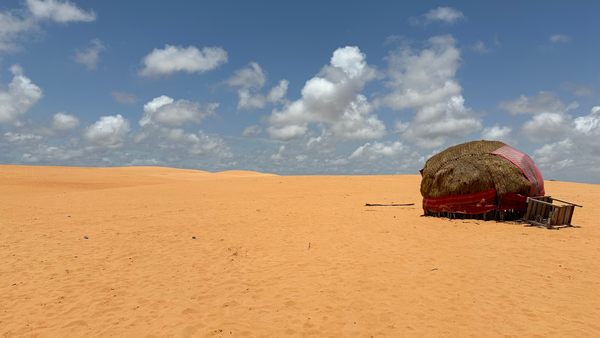The striking nature and relative rarity of red sand dunes means they’re usually tourist attractions wherever they occur. Well known examples include the Red Sand near Riyadh in Saudi Arabia, Sossusvlei in Namibia, and the Mui Ne Red Sand Dunes in Vietnam. While the Merka red dune complex is practically unknown by comparison, it has a unique feature that sets it apart: red sands and white sands run side-by-side, in places overlapping with one burying the other. Driving south from Mogadishu, you can see white sand on one side of you and red sand on the other.
Many different specific geological conditions had to come together in just the right way to create this landscape. To start, the city of Mogadishu is built over a layer of fossilized coral that flanks the coast, the remains of a reef that lived over 100,000 years ago. You can still walk on outcroppings of it in some places by the ocean. Coral is largely made of calcium carbonate, the same material eggshells are made of, and it’s this compound that gives the beach and coastal sand dunes their white color.
The red sand has a completely different origin. “Basement rock” is the term for the thickest and oldest part of the continental crust. It’s usually only located very deep underground, but in some cases it can emerge to the surface. In southern Somalia, the basement rock spent tens of millions of years at or above the ground, where it could erode into small particles of silicates like quartz, which colored the sand red. Inland away from the sea, this erosion has mostly come from rivers—and it just so happens that the Shebelle River runs very near and parallel to the coast.
The last piece of the puzzle is the wind. While the two sands were already close, it seems that in the past, the prevailing wind directions were exactly right to slowly push the two further together. Due to their fragility, the key minerals in the white sand can break down during transport, and so the red sand has been pushed towards the shore more than the white sand has been pushed inland. The final result just outside Mogadishu is that red dunes begin nearly immediately after a long white sand beach ends.
In most other countries, the Merka red dunes would probably have become well known to the world. Vietnam’s red sand dunes are already famous for having a white sand dune counterpart “only” 24 kilometers (15 miles) away, allowing visitors to experience two different landscapes in the same day; yet the Merka dunes let visitors experience two different landscapes in the same minute. Due to violent conflict though, tourism to Somalia was long impossible and today still remains minimal. Although some of the dunes are now officially visitable, they stretch for hundreds of kilometers and cross some highly unstable and dangerous areas, ensuring much of the sand stays off limits.
The upside of this has been the dunes’ preservation. More famous dunes have suffered serious degradation due to litter, constant foot traffic, and thrill-seekers on ATVs or motorbikes. The Merka red dunes aren’t exactly untouched, since people have lived near them for thousands of years, but contact has been at more sustainable levels. Snail shells that are six or seven thousand years old can still be found undisturbed at or near the sand’s surface.
Whether it will stay like this though remains to be seen. Proposals have been put forward to mine the sand for valuable elements and minerals, or to use it for the glass industry. Sand is a surprisingly lucrative resource, to the point where the majority of African nations have suffered from illegal sand mining. Somalia seems to have avoided this thus far, but if stability continues to slowly increase, exploiting the country’s natural resources will become more attractive. There is a potential future where the Merka dunes are destroyed before most people can enjoy them.

